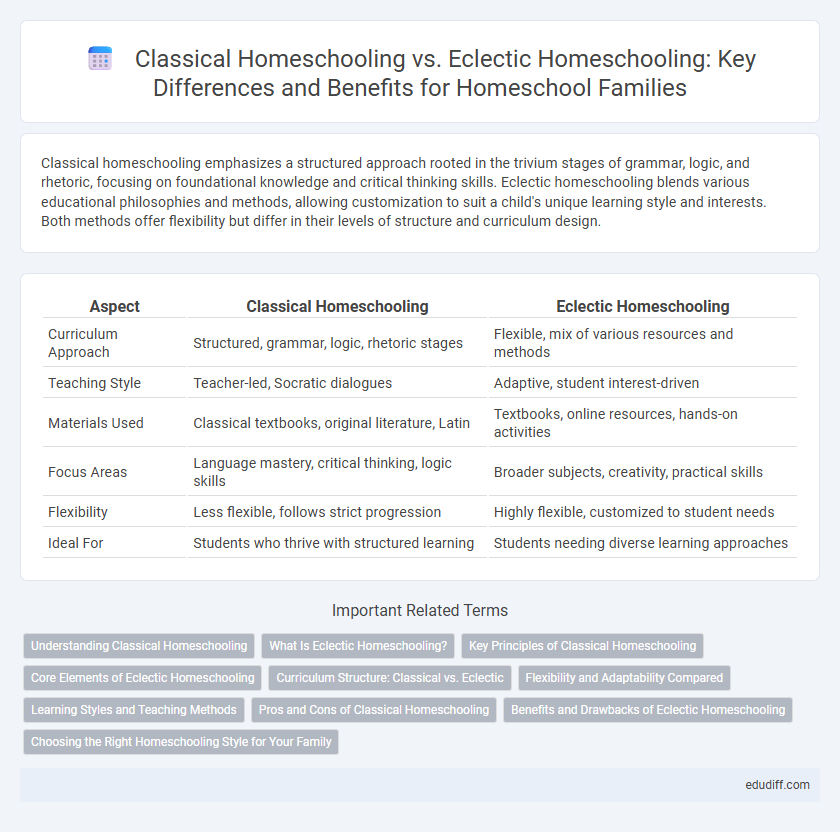Classical homeschooling emphasizes a structured approach rooted in the trivium stages of grammar, logic, and rhetoric, focusing on foundational knowledge and critical thinking skills. Eclectic homeschooling blends various educational philosophies and methods, allowing customization to suit a child's unique learning style and interests. Both methods offer flexibility but differ in their levels of structure and curriculum design.
Table of Comparison
| Aspect | Classical Homeschooling | Eclectic Homeschooling |
|---|---|---|
| Curriculum Approach | Structured, grammar, logic, rhetoric stages | Flexible, mix of various resources and methods |
| Teaching Style | Teacher-led, Socratic dialogues | Adaptive, student interest-driven |
| Materials Used | Classical textbooks, original literature, Latin | Textbooks, online resources, hands-on activities |
| Focus Areas | Language mastery, critical thinking, logic skills | Broader subjects, creativity, practical skills |
| Flexibility | Less flexible, follows strict progression | Highly flexible, customized to student needs |
| Ideal For | Students who thrive with structured learning | Students needing diverse learning approaches |
Understanding Classical Homeschooling
Classical homeschooling emphasizes a structured, three-part learning process known as the trivium, which includes grammar, logic, and rhetoric stages tailored to a child's developmental phases. This approach prioritizes mastering foundational knowledge before progressing to critical thinking and expressive skills, often integrating classical literature, history, and languages such as Latin. Unlike eclectic homeschooling, which customizes curriculum from diverse methods and resources, classical homeschooling maintains a disciplined, time-tested framework focused on intellectual rigor and character formation.
What Is Eclectic Homeschooling?
Eclectic homeschooling combines various educational approaches tailored to a child's unique needs, blending traditional methods with modern resources for a personalized learning experience. Unlike classical homeschooling, which follows a structured, chronological curriculum emphasizing grammar, logic, and rhetoric stages, eclectic homeschooling adapts subjects and materials to fit the student's interests and pacing. This flexible approach often includes mix-and-match curricula, hands-on activities, and digital tools to create a diverse and engaging educational environment.
Key Principles of Classical Homeschooling
Classical homeschooling centers on the Trivium, which divides learning into the Grammar, Logic, and Rhetoric stages to build foundational knowledge, critical thinking, and effective communication skills. It emphasizes mastery of classical languages like Latin and Greek alongside a Great Books curriculum that fosters intellectual rigor and moral development. Unlike eclectic homeschooling, which blends diverse methods and content, classical homeschooling adheres to a structured, time-tested framework aimed at cultivating wisdom and virtue through disciplined study.
Core Elements of Eclectic Homeschooling
Eclectic homeschooling integrates diverse teaching methods, combining structured lessons with flexible, child-led learning to accommodate individual student interests and learning styles. Core elements include a customized curriculum drawn from multiple educational philosophies, adaptive pacing based on the child's progress, and the incorporation of various resources like textbooks, online programs, and hands-on activities. This approach emphasizes personalization, allowing parents to blend classical education's rigor with creative, experiential learning to foster critical thinking and engagement.
Curriculum Structure: Classical vs. Eclectic
Classical homeschooling follows a structured, chronological curriculum rooted in the trivium stages: grammar, logic, and rhetoric, emphasizing classical literature, Latin, and critical thinking skills. Eclectic homeschooling offers a flexible, customizable curriculum blending various educational philosophies and resources, tailored to the child's interests and learning pace. The classical approach prioritizes mastery of foundational knowledge through systematic progression, while eclectic homeschooling adapts content dynamically for broader, individualized learning experiences.
Flexibility and Adaptability Compared
Classical homeschooling follows a structured, chronological approach emphasizing the trivium stages of grammar, logic, and rhetoric, making flexibility more limited but ensuring deep mastery of core subjects. Eclectic homeschooling offers greater adaptability by integrating diverse curricula and teaching methods tailored to a child's interests and learning pace. This flexibility allows for a personalized education plan that can easily adjust to evolving academic needs and family schedules.
Learning Styles and Teaching Methods
Classical homeschooling emphasizes a rigorous, structured approach centered on the trivium--grammar, logic, and rhetoric--catering to analytical and sequential learning styles through memorization, critical thinking, and Socratic dialogue. Eclectic homeschooling integrates multiple educational philosophies and adapts teaching methods to individual learners, supporting diverse learning styles such as kinesthetic, visual, and auditory by combining hands-on activities, multimedia resources, and flexible curriculum choices. Both approaches prioritize personalized education but differ in their reliance on traditional methodologies versus adaptable frameworks to optimize student engagement and comprehension.
Pros and Cons of Classical Homeschooling
Classical homeschooling emphasizes the Trivium, focusing on grammar, logic, and rhetoric stages that build a strong foundation in critical thinking and effective communication. Pros include structured, rigorous academic development and a deep understanding of Western literature and history; cons involve a potentially rigid curriculum and less flexibility to adapt to individual learning styles or interests. This method suits families valuing traditional education and discipline but may challenge those seeking a more fluid or varied approach.
Benefits and Drawbacks of Eclectic Homeschooling
Eclectic homeschooling offers flexibility by combining various teaching methods, allowing parents to tailor education to their child's unique learning style and interests, which can boost engagement and adaptability. However, its lack of a structured curriculum may lead to gaps in knowledge and require significant parental involvement to maintain balance and consistency. This approach benefits families seeking personalized education but demands careful planning to ensure comprehensive academic coverage.
Choosing the Right Homeschooling Style for Your Family
Classical homeschooling emphasizes a rigorous, structured approach rooted in the trivium stages: grammar, logic, and rhetoric, promoting deep understanding of foundational subjects like Latin, history, and literature. Eclectic homeschooling offers flexibility by blending multiple educational philosophies to tailor lessons to a child's interests and learning pace, incorporating resources from Charlotte Mason, Montessori, and unit studies. Families must evaluate their educational goals, children's learning styles, and available resources to select a homeschooling style that fosters engagement and academic growth effectively.
classical homeschooling vs eclectic homeschooling Infographic

 edudiff.com
edudiff.com